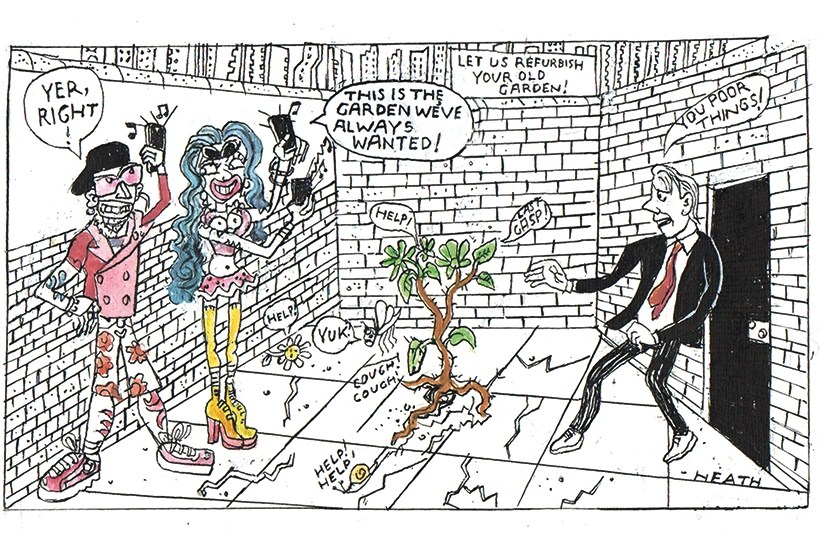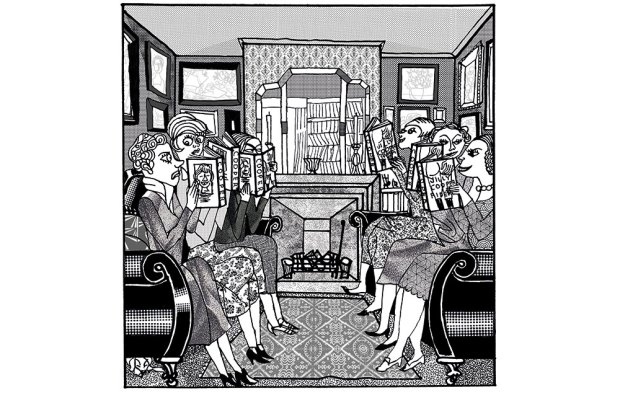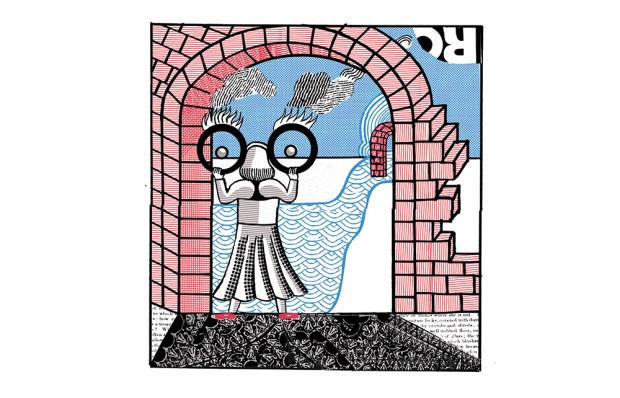Gardening is dead. It had been ailing for a long time and it sometimes looked as though it might pull through. But I knew it had finally kicked the bucket when the last of the three patches of grass I used to be able to see behind my house was replaced with a plastic lawn.
Then there was a ghastly death rattle: plastic ivy was draped over an electric gate which serves to let the owner’s car into the paved area formerly known as the front garden. And that came after the arrival of dozens of plastic balls in the neighbourhood. They are supposed to be imitations of Buxus sempervirens trimmed into a ball shape but their relentless perfection and over-vibrant colour means they don’t deceive anyone. They must be wonderfully low-maintenance. So are all the many front gardens now paved over with bright marble with only a bit of hedge at the front. The hedge is often brought in fully grown and then it quietly dies because it isn’t watered.
Yes, there are still some plants around. Where I live in Kensington, they are brought along in the vans of exterior designers. It would be wrong to call them gardeners. Their job is to provide instant, preferably evergreen, outside rooms requiring little or no maintenance. Consequently the borough has many walls covered with Trachelospermum jasminoides which is evergreen, tolerates some shade, does not grow too quickly and produces inoffensive, fragrant little white flowers about now. As for real gardens — ones that tend to be cared for by ageing widows; ones full of romance and love — they are dying out.
The planted area of London’s private gardens was reduced in size by the equivalent of 21 Hyde Parks between 1998 and 2006. The area covered by lawn was down 16 per cent and hard surfaces had increased by 26 per cent. If, as seems likely, those trends have continued, London’s hard surfaces in gardens will have increased by more than three quarters since 1998 and 63 Hyde Parks will have been paved over.
This is happening not just in London or even Britain. It is worldwide. Plastic lawns are booming. Global sales are predicted to have risen from $2.5 billion to $5.8 billion in the five years to 2023. Some of these lawns — or outside carpets — are given names to suggest that they still bear some relation to beauty or nature, such as ‘Linden’ or ‘Maple’. But they are really lifeless, plastic materials such as polyethylene, polypropylene or polyamide with an underside of latex. These plastic lawns probably last ten years or so before a new owner comes along or they become a bit grotty. Then they are sent to landfill, doubtless to be replaced by ‘new, improved Linden’.
British plant growers have also been in decline. Only 10 per cent of the money spent on flowers and plants in Britain goes to UK growers. There used to be 120 chrysanthemum growers here in the 1970s. By 2010, this was down to three.
Our gardens — or outdoor rooms — are now places for decking, tables, chairs and perhaps a bar. Behind me, California has arrived in the form of a vast corner sofa which has to be covered in black sheeting whenever rain threatens which, this being England, it often does. Our neighbour uses her outdoor room for her rigorous daily exercises to thumping music as her toned personal trainer looks on.
And why shouldn’t she (apart from the music)? It’s not a crime. Does it matter? Let me put it this way: have you ever seen a child make a daisy chain out of a plastic lawn? Life will go on but something has been lost. There is a reduction of contact with nature and the seasons, especially for those of us who are town-dwellers. The celebrated Dutch gardener Piet Oudolf argues that perennials — plants which die away each year and return to life in the spring — should be left alone and not cut down when they turn brown in autumn. They are part of the passing of the year, the cycle of life and death. They take on new shapes and silhouettes as they die off. They create a different atmosphere. Yes: atmosphere! That is something that the new outdoor rooms don’t have.
It is satisfying, too, to plant some bulbs of daffodils, snowdrops or alliums and see the flowers come up the next year and perhaps for many years. It has been a sign of someone who gardens with love that they plant a lilac or two. It looks drab for most of the year but for a few weeks it produces spectacular flowers with a sensational scent. You make sacrifices for what you love.
A garden can be a work of art. It doesn’t matter whether your taste is for the formal, with clipped hedges, topiary and statuary, or for the wild meadow look. By all means follow the fashion for exotics — figs and palms. Maybe you might go for the picturesque and put up an arch with roses climbing over it. Whatever you do, it is an act of creation which can bring profound satisfaction.
What makes the death of gardening particularly sad here in Britain is that for several centuries we have been outstanding at the art. We have produced some of the best and most influential gardeners, from Capability Brown to Gertrude Jekyll, from Major Lawrence Johnston (creator of Hidcote), to Russell Page, on to more recent stars such as Penelope Hobhouse, Rosemary Verey and Dan Pearson. Many of these eminent gardeners have been women and the decline of British gardening is largely because women nowadays lead different kinds of lives.
Above all, they have jobs. And they are trying to juggle these with giving time to their children, attending their Pilates/yoga/boxing classes and having coffee with their friends. They have every right to choose that lifestyle if, indeed, they have a choice at all. Whether it makes them happier than their mothers or grandmothers I don’t know. I guess they have gained self-respect and autonomy by working but they are trying to do a lot. And in the process, the gentle pleasure of gardening has been squeezed out.
We humans are full of contradictory impulses and desires. Among them, we want excitement and a full life. But, at the same time, we yearn for peace, contact with nature and inner satisfaction. None of us can have it all.
Goodbye gardening. You were a rather lovely episode in British history.
Got something to add? Join the discussion and comment below.
Get 10 issues for just $10
Subscribe to The Spectator Australia today for the next 10 magazine issues, plus full online access, for just $10.
You might disagree with half of it, but you’ll enjoy reading all of it. Try your first month for free, then just $2 a week for the remainder of your first year.














Comments
Don't miss out
Join the conversation with other Spectator Australia readers. Subscribe to leave a comment.
SUBSCRIBEAlready a subscriber? Log in